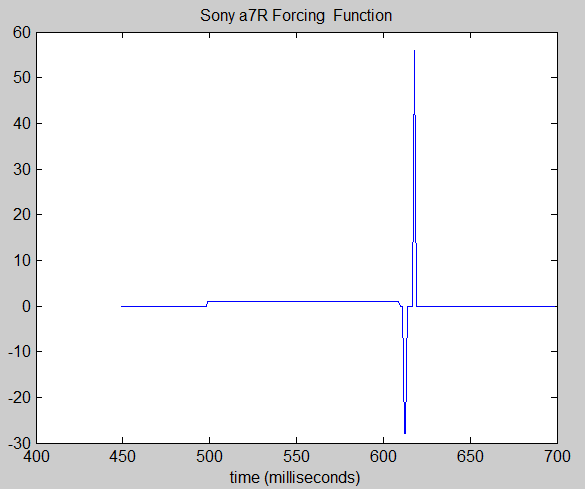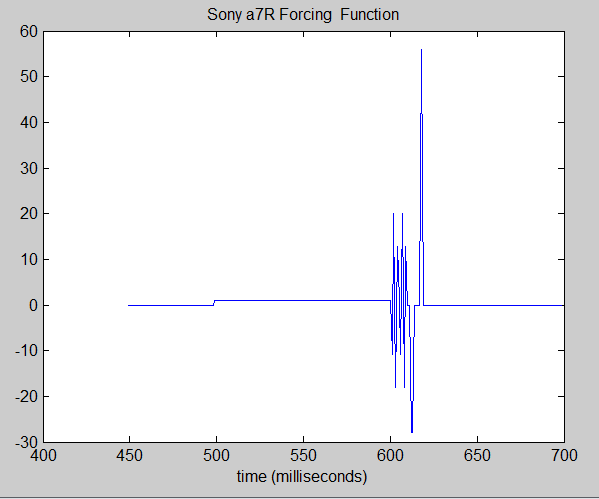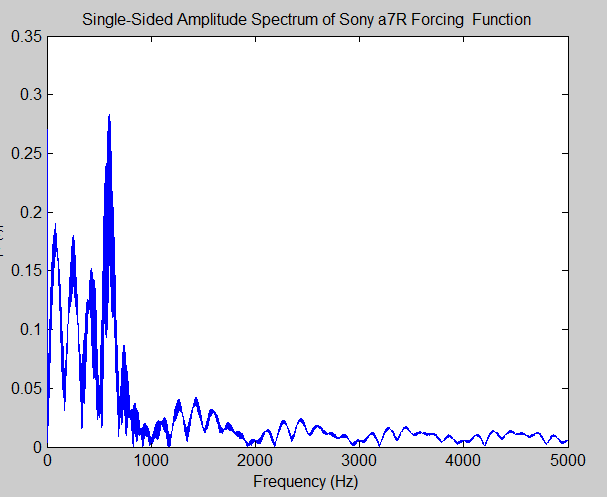I ended yesterday’s post with this:
In order to pick the right mass, spring stiffness, and damping to minimize camera movement in response to shutter movement, we have to know something about the forcing function created by the shutter movement, and also about the range of shutter speeds that are important.
Today I’m going to talk about the forcing function.
There’s a great simplification to our discussions that’s possible because of the contributions of a Frenchman named Joseph Fourier who lived about two centuries ago. He discovered that any waveform could be duplicated by summing sine and cosine waves of various frequencies and amplitudes. We can put that together with something called the superposition principle, which applies to linear systems like our simplified automobile (and, to a first-order approximation, our camera/tripod system), and be confident that the displacement of our vehicle or camera to any forcing function is the sum of its displacement to each of the frequencies contained in that forcing function.
So what do we know about the forcing function of shutter motion in focal plane shutter cameras in general, and the a7R in particular? Again, I’m going to simplify the heck out of what is a complex problem; see here for an idea of how complicated the Sony a7R shutter operation is. When you press the shutter release on the a7R, the shutter is wound, then the first curtain is released, then the second curtain is released. The second curtain travels from the top of the image to the bottom. I know that because of the images I made when I was experimenting with using an electronic flash at shutter speeds higher than 1/160 second. That means that the second curtain travels from the bottom of the camera to the top. In focal plane shutters, both curtains travel the same direction.
So the Sony a7R shutter motion forcing function consists of the effects of both curtains being wound into position (downwards), followed by the first curtain rising, followed by the first curtain stopping. Theoretically, the motion of the second curtain upwards also causes a force that occurs while the shutter is open, but closing. However, my testing indicates that this does not affect the images recorded by the sensor, at least when the second curtain and the first are not moving at the same time. So we have the first and second curtain and their ancillary hardware moving more or less slowly in one direction, followed by the first curtain moving fairly rapidly in the other direction, followed 1/160 second later by the first curtain stopping suddenly – really suddenly, in the a7R from the sound of the shutter and all the high-frequency effects we see in the images. Since the inertia of a body is its mass times its velocity, and the first derivative of that with respect to time is the force involved, the forcing function of the a7R’s shutter looks something like this:
In the frequency domain, the above time series looks like this:
For this model, I assumed the first and second curtain have the same mass. Winding the shutter into place doesn’t cause much force, even though the mass is double that of either curtain, since it takes 112 milliseconds. I’m figuring it takes the first curtain 2 milliseconds to get up to speed when it’s fired, which causes a lot of force, and that it takes the first curtain 1 milliseconds to stop, which causes even more force.
From Mike Collette’s vibration trace and analysis, it looks like the motor that winds the shutter causes a lot of vibration particularly at the end of its cocking cycle. Looking at the trace, it appears that the period is about 1.7 milliseconds, or 600 Hz. That number could be way off, since from looking at what happens in Mike’s setup when the first curtain stops, the ringing frequency is about the same, indicating that the camera and its mount have a resonance at that frequency. On the other hand, the motor-stop ringing is not a damped sinusoid like the first-curtain end-of-travel, so it’s possible that there’s a sinusoid in the forcing function due to the motor. It’s hard to tease out the forcing function from looking at the resulting movement, but I thought I’d add some motor-induced excitation, so we get this:
In the frequency domain, the above looks like this, zooming out a bit:
Now that I consider the physics involved, I’m beginning to appreciate what the Sony engineers probably meant when they said one of the toughest challenges in the design of the a7 and a7R was getting the shutter to work in such a small space. Here’s what I think they were talking about. You don’t want to have either shutter curtain’s pre-firing position to be right at the image edge, because that means that the curtain has no time to get up to speed before it starts exposing the sensor, and the first part of the exposed image will get too much light. So you want the curtain to start moving, let it get up to speed, and then have it start to expose the image. But that take room. If you don’t have the room, you have to accelerate the shutter more, and that causes higher frequencies in the forcing function.
Similarly, when the shutter curtain reaches its end of travel, you can’t stop it right at the edge of the image; you need to stop it after it’s left the image area. But if you don’t have much room, you need to stop it fast. Thus, in a small camera, you have to decelerate the curtain at a higher rate, and that causes higher frequencies in the forcing function.
It is possible that the a7R’s unusual shutter shock behavior is partly due to this engineering tradeoff, and not just to the winding of the shutter when the shutter release in pressed.
It’s clear from the frequency-domain plots that, if the forcing function is anywhere near what I’m postulating, we have a lot of high-frequency energy to deal with.




Leave a Reply